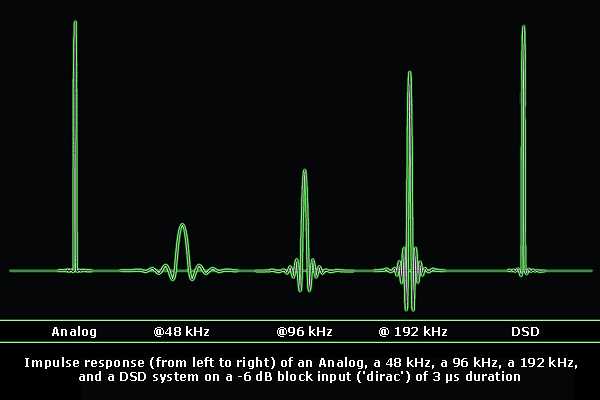StudioSound
100+ Head-Fier
- Joined
- Nov 24, 2012
- Posts
- 390
- Likes
- 34
There has been a lot of interest in DSD recently, with a lot of the higher-end DACs adding support for it.
But is DSD actually any better than PCM?
Even from papers which are pro-DSD, you have graphs like this:

So DSD has lower noise below 20kHz, and significantly higher noise above 20kHz.
But one of the arguments I hear about DSD or "HD" audio in general, is that ultrasonic sound can be "experienced" even if it cannot be heard.
In that case, with PCM having a flat noise floor of -144dB to the nyquist limit (half the sample rate - so 24/96 can represent signals up to 48kHz) doesn't PCM fare better?
What audio gear actually has a noise floor lower than -144dB, and furthermore, when is a -144dB noise floor ever going to be audible anyway? To hear that noise floor, isn't the signal going to be so loud that it will destroy your hearing?
Another pro-DSD argument I hear is that DSD doesn't require the anti-aliasing filter that PCM does - but we can clearly see that DSD needs a lot of filtering above 20kHz due to that ultrasonic noise.
Doesn't that also work in PCM's favor? With 24/96 PCM, you can use a gentle roll-off, rather than the brickwall filter required for redbook audio. (16/44.1)
The "Dirac pulse"

Wow, PCM looks terrible here!
But it's my understanding that all a Dirac pulse is entirely simulated, and all it actually does is show the filters in use.
What you see here is not going to be a part of an actual audio signal, and while you can see a difference in this graphic, there would not be an audible difference.
And finally - you can't edit DSD. If there has been any editing performed during the mastering phase, the audio will have been converted to PCM (probably DXD - 24/352.8) to do the processing, and then converted back to DSD... so you lose any "advantages" DSD may or may not theoretically have, and have just added ultrasonic noise compared to straight PCM mastering.
Is all this recent DSD hype just another thing manufacturers have come up with to sell you new hardware or "better" recordings?
But is DSD actually any better than PCM?
Even from papers which are pro-DSD, you have graphs like this:

So DSD has lower noise below 20kHz, and significantly higher noise above 20kHz.
But one of the arguments I hear about DSD or "HD" audio in general, is that ultrasonic sound can be "experienced" even if it cannot be heard.
In that case, with PCM having a flat noise floor of -144dB to the nyquist limit (half the sample rate - so 24/96 can represent signals up to 48kHz) doesn't PCM fare better?
What audio gear actually has a noise floor lower than -144dB, and furthermore, when is a -144dB noise floor ever going to be audible anyway? To hear that noise floor, isn't the signal going to be so loud that it will destroy your hearing?
Another pro-DSD argument I hear is that DSD doesn't require the anti-aliasing filter that PCM does - but we can clearly see that DSD needs a lot of filtering above 20kHz due to that ultrasonic noise.
Doesn't that also work in PCM's favor? With 24/96 PCM, you can use a gentle roll-off, rather than the brickwall filter required for redbook audio. (16/44.1)
The "Dirac pulse"

Wow, PCM looks terrible here!
But it's my understanding that all a Dirac pulse is entirely simulated, and all it actually does is show the filters in use.
What you see here is not going to be a part of an actual audio signal, and while you can see a difference in this graphic, there would not be an audible difference.
And finally - you can't edit DSD. If there has been any editing performed during the mastering phase, the audio will have been converted to PCM (probably DXD - 24/352.8) to do the processing, and then converted back to DSD... so you lose any "advantages" DSD may or may not theoretically have, and have just added ultrasonic noise compared to straight PCM mastering.
Is all this recent DSD hype just another thing manufacturers have come up with to sell you new hardware or "better" recordings?
